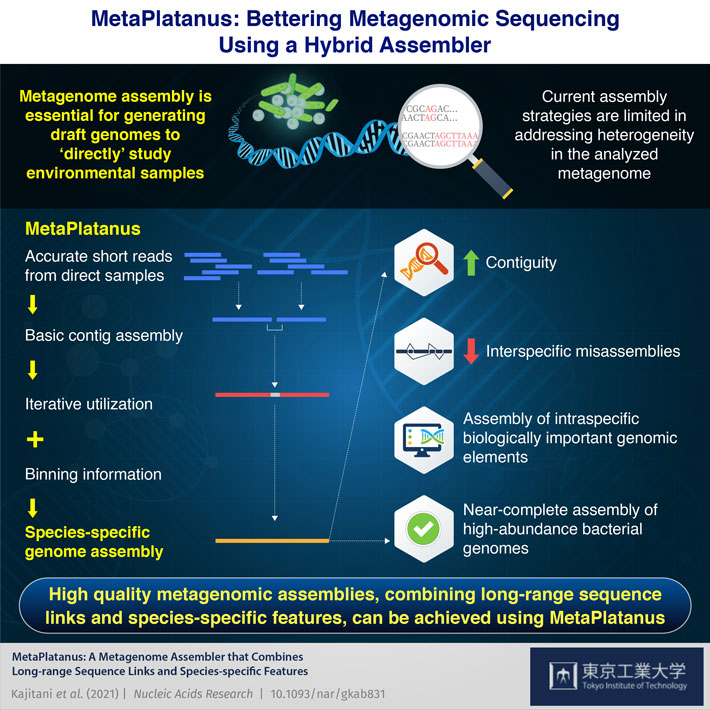Life Science and Technology News
Sequencing the Unknown Made Easy: MetaPlatanus Improves Metagenome Assembly
Metagenome sequencing of "tricky" gene pools has been ridden with issues during assembly of sequenced DNA fragments, which can now be addressed by a tool developed by scientists from Tokyo Institute of Technology (Tokyo Tech). This hybrid metagenome assembler tool, called MetaPlatanus, utilizes long-range sequence links and species-specific features, to deliver high quality DNA sequences.

Metagenomics often involves sequencing DNA samples that can only be described as "tricky." Such DNA shows high heterogeneity, which can cause interspecies misassemblies. These misassemblies threaten the very purpose of metagenome sequencing, which is to comprehensively study the gene pool, by generating multiple draft genomes in a given sample. This issue is further complicated by the presence of certain organisms in these samples that cannot be cultured using standard microbiology techniques. How can this cascade of issues be resolved?
Scientists from Tokyo Tech now have the answer. They have developed a novel metagenome assembler called MetaPlatanus, which can generate accurate DNA sequences, including those of uncultured organisms. Their breakthrough findings have been published as a research article in Nucleic Acids Research![]() .
.
MetaPlatanus uses accurate short DNA sequence reads to assemble contigs. Contigs are slightly longer stretches of DNA sequence that are analogous to jigsaw puzzle pieces in the larger genome. The contigs are assembled into larger chromosome-scale scaffolds by repeatedly using inputs like long-range sequence links, species-specific sequence compositions, coverage depth, and binning information.
Explaining the choice of inputs for MetaPlatanus-based scaffold generation, Dr. Rei Kajitani, Assistant Professor at the School of Life Science and Technology, Tokyo Tech, and the lead scientist of the study, says, "We employ a hybrid metagenome assembly method that not only utilizes the advantages of both short-range and long-range sequence reads, but also compensates for the shortcomings posed by either read lengths, and the sample itself."
He further adds, "We have applied binning to link sequences divided by regions that are hard to assemble, such as repetitive ones. Our approach is novel since the combination of binning and assembly processes have not been implemented as a public tool, so far!"
Dr. Kajitani and his team left no stone unturned in checking the accuracy of results churned out by MetaPlatanus. In this regard, they performed a process called benchmarking using mock datasets of known bacteria. Not surprisingly, MetaPlatanus gave outputs that were highly contiguous, with very few interspecies misassemblies.
Notably, while testing MetaPlatanus' accuracy with already published human gut data, it additionally assembled many biologically important elements, including coding genes, gene clusters, viral sequences, and over-half bacterial genomes.
Also, compared to other existing tools, only MetaPlatanus was able to perform near-complete assembly of some high-abundance bacterial genomes, while benchmarking using already published human saliva data.
Indeed, Dr. Kajitani and his team appear to have struck metagenomic gold with MetaPlatanus. Excited about the potential applications of MetaPlatanus, he exclaims, "We believe that the metagenome assembler that we have developed at Tokyo Tech could help examine the contexts of sequence elements spreading over the genome, which could have innumerable real-world applications."
Undoubtedly, this study could prove to be a milestone in the field of metagenomics.
- Reference
| Authors : | Rei Kajitani1, Hideki Noguchi2, Yasuhiro Gotoh3, Yoshitoshi Ogura4, Dai Yoshimura1, Miki Okuno4, Atsushi Toyoda2,5, Tomomi Kuwahara6, Tetsuya Hayashi3, and Takehiko Itoh1,* |
|---|---|
| Title of original paper : | MetaPlatanus: a metagenome assembler that combines long-range sequence links and species-specific features |
| Journal : | Nucleic Acids Research |
| DOI : | |
| Affiliations : | 1 School of Life Science and Technology, Tokyo Institute of Technology, Japan 2 Advanced Genomics Center, National Institute of Genetics, Japan 3 Department of Bacteriology, Graduate School of Medical Sciences, Kyushu University, Japan 4 Division of Microbiology, Department of Infectious Medicine, Kurume University School of Medicine, Japan 5 Comparative Genomics Laboratory, National Institute of Genetics, Japan 6 Department of Molecular Microbiology, Faculty of Medicine, Kagawa University, Japan |
| * Corresponding author's email: | E-mail : takehiko@bio.titech.ac.jp |
- Research on Lake Victoria Cichlids Uncovers the Processes of Rapid Species Adaptation | Life Science and Technology News
- Gene regulation behind the choice of the correct receptor for olfaction | Life Science and Technology News
- Researcher Profile | Tokyo Tech STAR Search - Rei Kajitani
- Researcher Profile | Tokyo Tech STAR Search - Takehiko Itoh
- Department of Life Science and Technology, School of Life Science and Technology
- Latest Research News
School of Life Science and Technology
—Unravel the Complex and Diverse Phenomena of Life—
Information on School of Life Science and Technology inaugurated in April 2016
Further Information
Assistant Professor Rei Kajitani
School of Life Science and Technology, Tokyo Institute of Technology
E-mail : rkajitan@bio.titech.ac.jp






